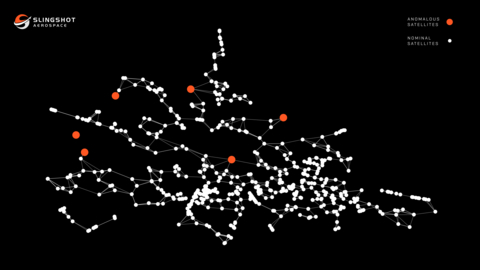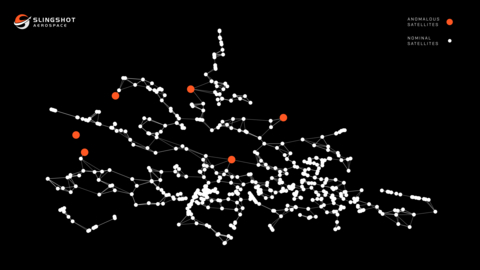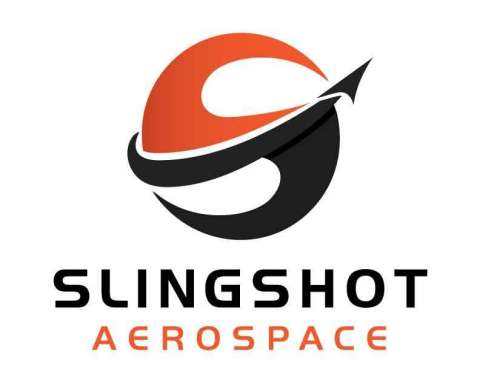EL SEGUNDO, Calif.--(BUSINESS WIRE)--Slingshot Aerospace, Inc., the leader in AI-powered solutions for satellite tracking, space traffic coordination, and space modeling and simulation, today announced it has worked with the Defense Advanced Research Projects Agency (DARPA) to successfully create a new artificial intelligence (AI) system, called Agatha, that identifies anomalous spacecraft within large satellite constellations.
Several large satellite constellations of over 10,000 spacecraft are slated for deployment by international government and commercial space operators in the coming years, which will dramatically increase the number of satellites in low Earth orbit (LEO). With so many satellites, it becomes increasingly important to be able to verify that satellites are operating within the constellations’ stated purposes.
“Agatha represents a breakthrough in how AI can deliver unparalleled space domain awareness, as its ability to find these needles in the haystack is something no human, or team of humans, could possibly execute,” said Dr. Dylan Kesler, Director of Data Science and AI, Slingshot Aerospace. “Identifying malfunctioning or potentially nefarious objects and their objectives within large satellite constellations is a complex challenge that required us to reach beyond traditional approaches and develop a novel and scalable AI algorithm. Our Agatha model has also proven its ability to deliver high-quality insights that provide ‘explainability’ or context for why specific objects were flagged.”
Slingshot’s Agatha was trained on over 60 years of simulated constellation data that Slingshot created. Slingshot then closed the so-called “sim-to-real transfer" gap and proved-out the system by finding non-nefarious outliers in operational, real-world commercial constellations. After identifying a number of outlier satellites within those constellations, Slingshot successfully confirmed with the respective satellite operators that the identified satellites did differ from the others in hardware, mission, and/or operational parameters.
Agatha AI incorporates cutting-edge approaches to AI data analysis, including inverse reinforcement learning (IRL) – a technique that uses AI to evaluate behaviors and identify the policies and intentions of the objects it tracks. IRL reaches beyond identifying individual outlier maneuvers (see Slingshot’s reporting on the Russian satellite Luch (Olymp) 2) and focuses on answering the strategic questions of why satellites are exhibiting specific behaviors and what their intentions are. Further, Agatha doesn’t require cues on where to look for outliers – the data-agnostic model ingests massive amounts of space information and identifies anomalies as it finds them.
Given the scale of planned satellite deployments in the coming years – by the beginning of 2023, the International Telecommunication Union had received filings for more than 300 constellations representing more than 1 million satellites – AI technologies like Agatha are needed to monitor satellite constellations and track the growing number of objects in space. Agatha specifically analyzes high-resolution astrometric, contextual, and photometric data from the Slingshot Platform’s vast data lake, which aggregates data from the Slingshot Global Sensor Network, Slingshot Seradata, and other public and proprietary sources. Agatha also evaluates the locations and times of satellites’ communications with Earth and a variety of other data streams.
Slingshot’s PRECOG program, which produced the Agatha system, began in March 2023 and results were delivered to DARPA in January 2024; the program is complete. Slingshot is now focusing on implementing its powerful Agatha AI system and is engaged in ongoing discussions with the U.S. government and commercial space companies about methods for deploying Agatha as part of their advanced space domain awareness services.
“As space activity shifts from satellites owned by a small number of operators to massive constellations operated by an array of owners, the need for transparency increases,” said Kesler. “The ability to quickly identify anomalies – whether a malfunctioning spacecraft or an intentionally nefarious ‘wolf in sheep’s clothing’ – is an increasingly important aspect of maintaining safety and security in space and on Earth.”
“Having worked previously in the BioTech world and with gene editing technologies like CRISPR, I know that tools like Agatha and approaches like inverse reinforcement learning almost certainly would have helped us find anomalies in the oceans of genomic data we analyzed,” continued Kesler. “Inverse reinforcement learning is an AI technique on the bleeding edge of development and we expect its use to grow exponentially in the years to come to solve a variety of problems, not just in space.”
Given the adaptability and scalability of Agatha, it has a wide range of potential applications in domains beyond space. Its ability to ingest large series of data and effectively find anomalies in massive data streams means Agatha is well-suited to be applied in genomics, biomedicine, agriculture, and utility optimization, among other potential use cases.
About Slingshot Aerospace
Slingshot Aerospace provides government and commercial partners around the world with AI-powered solutions for satellite tracking, space traffic coordination, and space modeling and simulation. The Slingshot Platform transforms disparate space data into a common operating picture of the space domain by leveraging advanced space object tracking, artificial intelligence, astrodynamics, and data fusion. Slingshot’s platform combines data from the Slingshot Global Sensor Network, the Slingshot Seradata satellite and launch database, satellite owner-operators, and other third-party space data providers to create a holistic and dynamic view of space for training, planning, and operations. This unified representation of space activities – past, present, and predicted – enhances operators' space situational awareness, improves operational efficiency, and reduces risk for space operators. Slingshot is driven by its mission to make space safe, sustainable, and secure. The company was launched in 2017 and has locations in California, Colorado, and the UK.
Visit slingshot.space and follow Slingshot Aerospace on X and LinkedIn for the latest information.
The Slingshot Aerospace media kit, including photos, can be found HERE.




